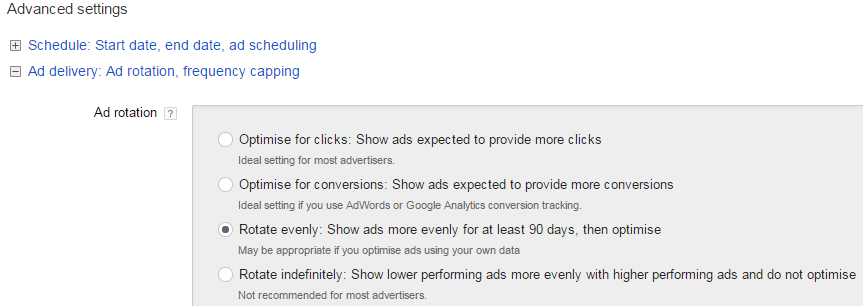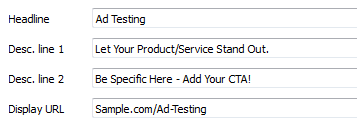Ad copy testing is a vital aspect of any PPC strategy. Whether you’re new to PPC or have been doing it for decades, ads should be tried and tested on a regular basis for optimum performance and maximum click-through rates (CTRs)!
Every PPC guru wants to encourage more traffic to either their own or their client’s site, but may not always have the financial backing for inflated cost per clicks (CPCs) to get there. This is where testing, testing and more testing comes into play. In a nutshell, the higher your CTRs, the more relevant Google deems your ads to be. In turn that will give your site higher quality scores, more clicks on your ads and lower CPCs – a PPC dream come true!
CTR is the key metric which determines Quality Score (QS), and Quality Score is a direct multiplier which determines cost per click. So carrying out even a small amount of ad testing will positively influence all of these key metrics – making your paid activity much more cost effective.
A couple of musts…
Before we jump into the best way of testing new ads, let’s first take a look at a couple of pointers behind the ‘what’ and the ‘why’…
1. What do you want to achieve?
“More clicks to your site?” or “More conversions with a lower cost per action?” Decide what you want and start tailoring your ads with your target goals in mind.
2. What is your target language?
As well as making your ads look eye catching in terms of grammar and punctuation, it is really important that you understand your target market. If you are selling travel insurance to the “over 70s” you will need to use language that is appropriate and well suited to that market, probably very different to language targeting teenagers for example. Google Analytics is a great way of understanding your target market; age demographic etc. Ensure your creative sits well in the market you are competing in.
3. What campaign settings to use?
When you are testing three entirely new ads, change your ad delivery setting to “rotate evenly”. This will allow your ads to be served evenly rather than showing one ad the majority of the time and enabling you to identify your best performing ads. Not sure where to find this?
Go to: Campaign Settings>Advanced Settings>Ad Delivery (see screenshot below)
Image from Google Adwords, July 2015
4. The big spenders…
Using high volume ad groups for your ad testing will allow you to analyse performance more effectively. There’s no benefit in starting your ad testing in an ad group which gets only five impressions a month. Believe me, you’ll be waiting a long time to see any results!
Let’s delve a little deeper
Ad testing is all about minimal effort for maximum reward. You can change just the smallest snippet of text in your ads, and this can make the world of difference to your campaign performance. And this is where we recommend you begin. Ad testing in paid search does not mean testing an entirely new ad each time – in fact, we would recommend starting with 2-3 ads with a slight ‘spot the difference’ in each one. So maybe you keep the entire ad the same but just change the 2nd description line in each ad. Or maybe you keep the entire ad the same, but test changing the headline. This way you can analyse performance very effectively to find your top performing ads. You can then create a new version of that ad keeping the winning aspect the same across all ads.
Think of it like a football tournament – test variations of your ads until you find the one achieving the highest CTRs at the cheapest CPCs. A little confusing, let’s take a look at some live examples…
Ad – version 1
Ad – version 2
If we look at the examples above, the only aspect I changed is the Description Line 1 (DL1). So if version 2 has the highest click through rate, I would then test that DL1 in both ads, instead changing the DL2. It’s a simple process of elimination.
To ensure you are effectively analysing the performance of your ads, make sure you run them for a long enough period of time. You may have an ad which has acquired one impression and had one click – 100% CTR. “I am a PPC King!?” But one impression and one click is not enough to fully understand how well it has performed. Allow enough traffic to go through each ad before deciding on the next ad copy test. On the other hand, don’t allow 1000s of clicks through to your ads before you make changes – you never know, you could have acquired double the amount of clicks through a new ad variation.
The key elements to a perfect ad
It is very tempting to test a new ad from scratch most of the time. However, best practice of ad testing requires extra patience with a strategy to follow. While you are working on A/B testing, you shouldn’t leave any room for doubt which may lead your testing to a failure. That is why it is very important to test one variable at a time and measure the outcomes of each changes. Subsequently, carry on to the next ad copy testing using your winner ad.
The beauty of Adwords if that you can change a whole host of aspects of your ads. You are not just limited to the main description lines, so use this opportunity to make your ads as compelling as possible, and win clicks over your competitors:
- Headlines: Start your testing with headlines. No doubt, headlines are the first text your potential customer will see when they are looking for your product or service. Make sure you add what exactly people are looking for in your headline that will stand out, along with your best offer if you have one. Do not include any attractive sale related term if you are not currently running any offer!
- Description Lines (1 and 2) : Use this space to make your messaging as attractive as possible without misleading visitors. As well as this, make full use of the space. So often we see advertisers only using half the description line space, making the ads much less attractive.
- Call to Action (CTA): Your CTA is your deal breaker. This is what you are asking from your customers to do, be specific here. Make sure to use strong phrases to lead your visitors. Don`t waste your precious description line with poor or complicated CTAs.
- Display URL: This is one of the most underrated and underused (for that matter) part of the ad. There are several ways you can test your URLs such as adding a keyword at the end of your URL or testing it as a sub-folder e.g. www.Sample.com/Summer-Sale www.Sample.com/Designer-Handbag
- Sitelink Extensions: Another great way for up-selling your products and services – Sitelink extensions allow you additional links to your site at the bottom of your ads’ descriptions lines. A lot of advertisers forget that Sitelink extensions contribute to your CTRs and Quality Scores. If Google recognises your sitelinks as assisting in a click on your ads – then you will pay less in CPCs.
Measure it!
Undoubtedly, click-through rate is the main metric which indicates the success of your ad testing. Make sure you understand your goals, your audiences and your competition for a solid ad-copy strategy.
Although ad-testing is can be seen as never-ending process, if it means your paid search activity is more cost effective, then it is well worth the time investment!





